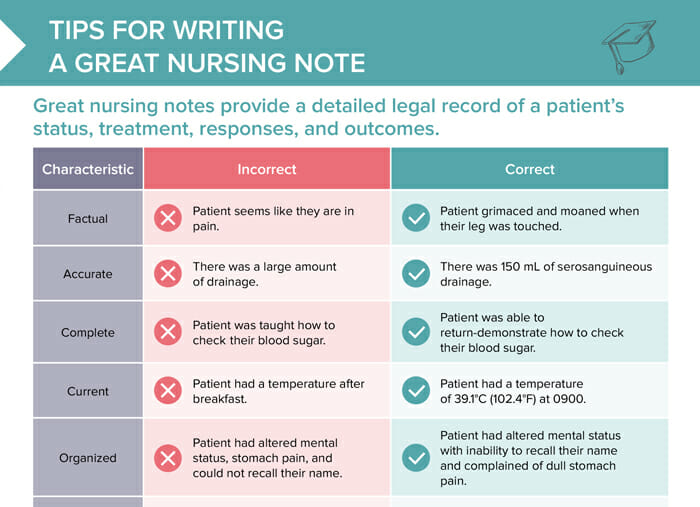What are nursing notes?
Nursing notes are written records detailing the care provided to a patient, including observations, treatment plans, and interventions. They are essential for continuity of care and are a legal document.
How to write nursing notes
Good nursing notes provide a detailed legal record of a patient’s status, treatment, responses, and outcomes.
All nursing notes must be:
- Factually correct
- Accurate and detailed
- Complete
- Current with exact time information
- Organized
- Professional
Tips for writing nursing notes:
- Be sure to document the correct patient, and under your own name and login.
- Document as soon as possible. Don’t wait until the end of the shift.
- Report and document missed or late entries immediately.
- Document the issue, what you did about it, and the patient’s response.
- Document only what you see, hear, touch, smell, and do—avoid opinions.
- Document often enough and with enough detail to tell the entire story.
- Document all communications—include names, titles, time, statements, and actions taken.
Free-form notes: nursing narrative notes
Writing nursing notes in a narrative format means telling the patient’s story chronologically. The note will provide the information in free, written-out sentences.
An advantage is that notes in this format provide context and a fuller picture of the client’s situation, but they can be time-consuming to read and write.
Nursing note template: SOAP nursing notes
“SOAP” is short for “Subjective, Objective, Assessment, and Plan”.
- Subjective: complaints and symptoms
- Objective: vital signs and other measurable data
- Assessment: clinical judgment
- Plan: treatments/intervention plans
Giving nursing notes this structure creates easier reading to scan quickly and reduces the possibility of errors and oversights by providing a standardized, focused documentation.
SOAPIE nursing note example
The SOAP-format is often expanded to “SOAPIE”: Subjective, Objective, Assessment, Plan, Intervention and Evaluation.
An example for this format would be:
- Subjective: Patient states: ‘I feel short of breath’
- Objective: Vitals signs showed: BP 110/75; HR 100; RR 22; SpO2 89%
- Assessment: Patient displays fatigue and is pale, states “tiredness”..
- Plan: This RN contacted the charge RN, rapid response nurse, and primary care physician.
- Intervention: Oxygen 2 L placed on the patient via nasal cannula.
- Evaluation: SpO2 increased to 95%, respiratory rate slowed to 18. The patient was transferred from the med-surg unit to the ICU due to unstable condition per healthcare provider order. Report given to ICU nurse; family notified of transfer.
Nursing note template (SOAPIE)
- Subjective: What did the patient report?
- Objective: Vital signs/lab values
- Assessment: What were your findings?
- Plan: Who did you contact?
- Intervention: Action/intervention(s) the nurse performed
- Evaluation: What happened after the interventions?
Good nursing note example: dos and don’ts
Following are examples of nursing note excerpts that show the dos and don’ts of how to follow the requirements of a good nursing note:
Make sure the nursing note is factual
Don’t: Patient seems like they are in pain.
Do: Patient grimaced and moaned when their leg was touched.
Interpretations and assumptions are not facts.
Make sure the nursing note is accurate
Don’t: There was a large amount of drainage.
Do: There was 150 mL of serosanguineous drainage.
“Large amount” as a quantifier leaves the information open to the reader’s interpretation. Stick to the facts and give them in the most detailed way possible.
Make sure the nursing note is complete
Don’t: Patient was taught how to check their blood sugar.
Do: Patient was able to correctly return-demonstrate how to check their blood sugar.
Include how the teaching was done and the proof that it was successful.
Make sure the nursing note is current
Don’t: Patient had an elevated temperature after breakfast.
Do: Patient had a temperature of 39.1°C (102.4°F) at 0900.
This example shows again that it is important to be specific, precise, and to give all the available information.
Make sure the nursing note is organized
Don’t: Patient had altered mental status, stomach pain, and could not recall their name.
Do: Patient had altered mental status with inability to recall their name and complained of dull stomach pain at a level of 5 out of 10.
Group related information together.
Make sure the nursing note is professional
Don’t: Patient uncooperative and would not take meds.
Do: Patient refused 0900 meds.
It is inappropriate to label patients as difficult, uncooperative, or use a negative description – simply state the actions, what happened, quotes stated and everything that may have kept you from taking measures you were supposed to. Leave out any personal perspectives, reactions, or feelings.

